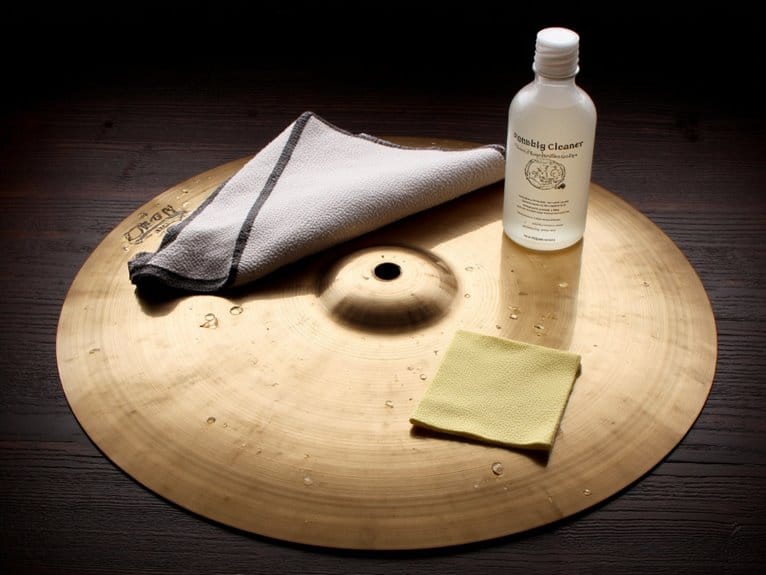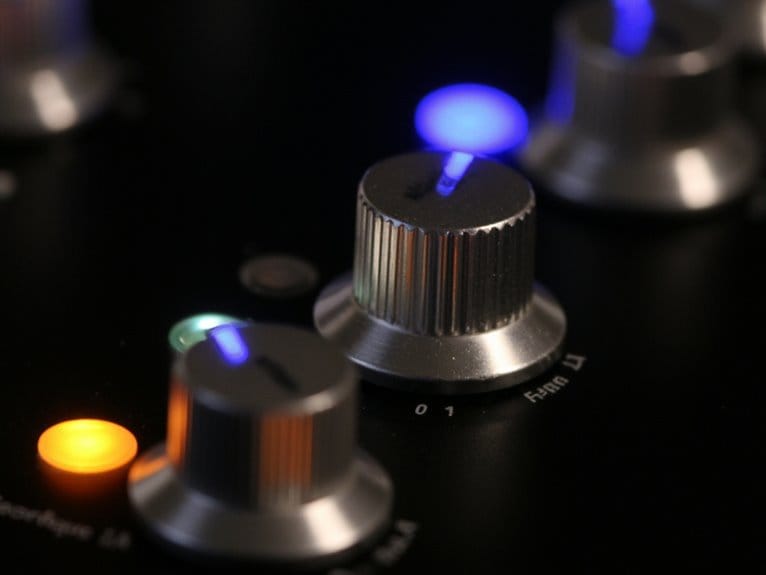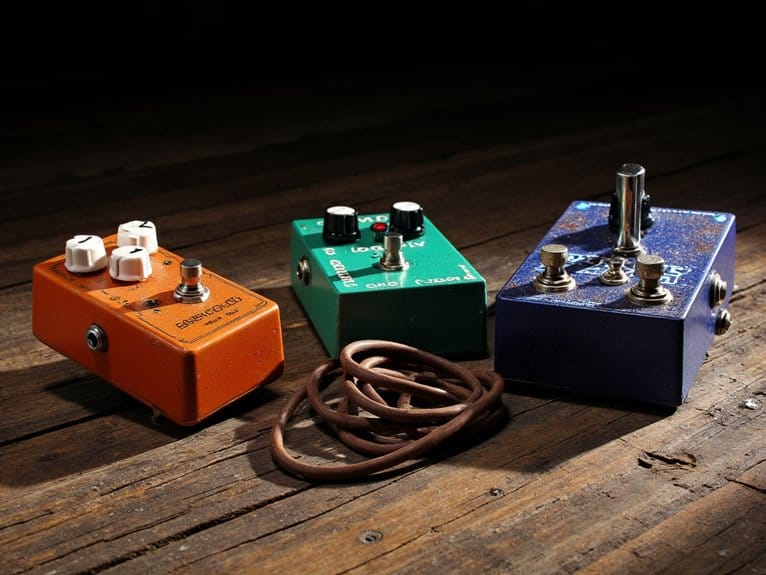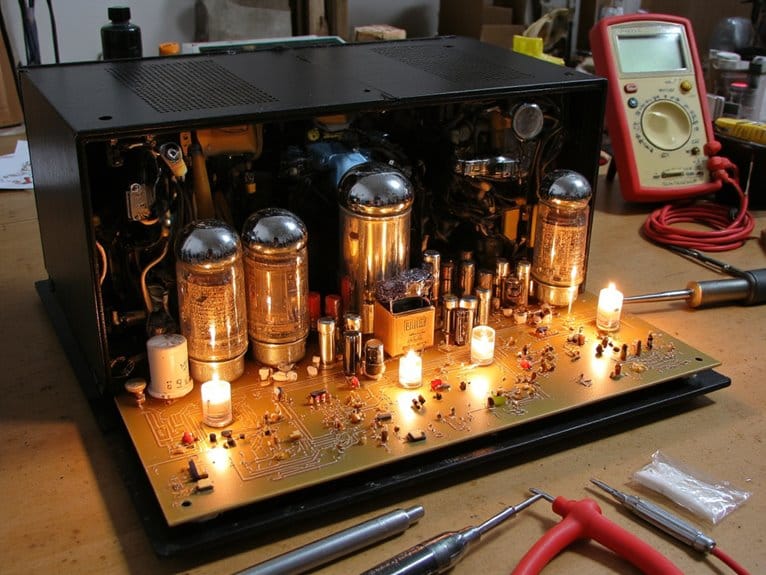Cymbal Care and Cleaning Guide
You’ll need acid-free cymbal cleaners and microfiber cloths to properly maintain your cymbals without damaging the bronze alloy surface. Start with daily post-session wipedowns using dry cloths, then perform deeper cleaning monthly by soaking in warm, soapy water and gently brushing grooves with a soft toothbrush. Different finishes require specific approaches—brilliant finishes need specialized polishes while raw finishes should develop natural patina. Store cymbals horizontally in padded cases, avoiding metal-to-metal contact and temperature fluctuations to prevent cracking and oxidation that compromises both appearance and tone quality.
We are supported by our audience. When you purchase through links on our site, we may earn an affiliate commission, at no extra cost for you. Learn more.
Notable Insights
- Use acid-free cymbal cleaners and microfiber cloths to remove oxidation without damaging bronze surfaces or affecting tone quality.
- Establish daily maintenance by wiping cymbals with dry microfiber cloths after each session to prevent oil and grime buildup.
- Deep clean by soaking cymbals individually in warm soapy water, then brush grooves gently with a soft toothbrush.
- Store cymbals horizontally in padded cases with protective cloth between each cymbal to prevent metal-to-metal contact and scratching.
- Avoid steel wool, over-polishing, and excessive cleaning frequency as these mistakes can strip protective coatings and damage surfaces.
Essential Cleaning Supplies and Products
When it comes to maintaining your cymbals’ sound quality and appearance, I’ve learned that choosing the right cleaning products can make the difference between preserving your investment and accidentally damaging expensive bronze alloys.
Choosing the right cleaning products can preserve your cymbal investment or accidentally damage expensive bronze alloys.
You’ll want to focus on acid-free cymbal cleaners that effectively remove oxidation layers without compromising the metal’s integrity, while specialized cleaners like Zildjian’s polish work exclusively on brilliant finishes. Professional formulations typically come in 8 fl. oz containers that provide enough product for multiple cleaning sessions while maintaining consistent performance.
I recommend investing in complete kits that include premium microfiber towels, polishing agents, and application tools, since having dedicated supplies prevents cross-contamination between different products. These comprehensive systems often feature fast-acting chemicals that efficiently restore your cymbals’ original shine while being gentle on the metal surface.
Many manufacturers now offer eco friendly products with recyclable packaging, which appeals to environmentally conscious drummers while delivering professional-grade results that repair shops actually approve and trust. Understanding the differences between bronze alloy and brass construction helps you select the appropriate cleaning approach for your specific cymbal materials.
Basic Cleaning Techniques and Methods
Your cymbal’s longevity depends on establishing consistent daily maintenance routines, which I’ve learned prevent the need for aggressive cleaning sessions that can damage delicate bronze surfaces.
When deeper cleaning becomes necessary, you’ll want to follow specific processes that work with your cymbal’s natural grain patterns, metal composition, and finish type to preserve both appearance and tonal characteristics. For stubborn dirt and grime, specialized cymbal polish should be your go-to solution rather than household cleaning products that can harm the metal.
The final step involves proper drying techniques that eliminate water spots, prevent oxidation, and guarantee your cymbals maintain their acoustic properties for years of reliable performance.
Daily Maintenance Methods
A pristine cymbal’s shimmer fades quickly without proper daily care, and I’ve learned through countless rehearsals that consistent maintenance prevents the gradual buildup of oils, sweat, and environmental grime that can permanently damage these delicate bronze alloys.
After each session, you’ll want to wipe down your cymbals with a dry microfiber cloth, focusing particularly on the bell and outer edges where grime accumulates most aggressively.
For deeper cleaning, I use a dampened cloth with mild soap solution, ensuring I dry the surface immediately to prevent water spots.
Regular cymbal rotation—turning them 180 degrees periodically—promotes even wear patterns, while thorough damage inspection after each use helps identify developing cracks or keyholing before they become irreparable problems.
Deep Cleaning Process
While daily maintenance keeps surface grime at bay, deep cleaning becomes essential when months of accumulated oils, stick residue, and environmental pollutants have created that telltale dullness that robs your cymbals of their natural brilliance and tonal clarity.
I’ve found that effective deep cleaning techniques start with proper preparation, using a large container filled with warm, soapy water for cymbal soaking. Remove any non-stick felts first, then submerge each cymbal individually to prevent scratching.
| Step | Action |
|---|---|
| Preparation | Fill container with warm water and mild dish soap |
| Soaking | Submerge cymbals individually for several minutes |
| Brushing | Use soft toothbrush following groove direction |
| Polishing | Apply cymbal-specific polish, avoiding harsh chemicals |
| Drying | Thoroughly dry with microfiber cloth, inspect for residue |
After soaking, gentle brushwork removes stubborn grime while specialized cymbal polishes restore that coveted shine.
Proper Drying Techniques
Once you’ve completed the deep cleaning process, proper drying becomes the make-or-break moment that determines whether your cymbals emerge with pristine surfaces or develop unsightly water spots and potential corrosion issues.
I always reach for microfiber cloths first, since they’re soft enough to prevent scratching while absorbing moisture effectively.
Pat along the grooves rather than rubbing sideways, which preserves your cymbal’s finish and prevents damage to delicate surfaces. Change your cloth frequently to avoid redistributing dirt or polish residue back onto clean metal.
Curiously, some drummers intentionally use drying agents like gaffer tape to alter their sound, reducing sustain while maintaining cymbal resonance without leaving sticky residue behind.
Caring for Different Cymbal Finishes
Your cymbal’s finish isn’t just about looks—it fundamentally determines how you should clean and maintain each piece in your kit, since brilliant and natural finishes require completely different approaches to preserve their distinctive sound characteristics.
I’ve learned through years of experience that treating a polished brilliant cymbal the same way you’d care for a raw, natural finish will either damage the shine or strip away the patina that gives each type its unique tonal qualities.
You’ll need to understand these differences before reaching for any cleaning products, because the wrong method can permanently alter your cymbal’s sound and appearance.
Brilliant Finish Maintenance
Brilliant finish cymbals, with their mirror-like surfaces and stunning visual appeal, demand a specialized maintenance approach that differs markedly from their natural or traditional finish counterparts.
You’ll need to use cymbal polishes specifically designed for brilliant finishes, like Zildjian’s specialized formula, which cleans and protects without damaging that pristine surface.
Brilliant finish polishing requires gentle application with soft cloths, avoiding aggressive rubbing that can dull the mirror-like appearance.
For oxidation prevention, I recommend applying protective coatings like Paiste Cymbal Protector after cleaning, creating a barrier against airborne contamination and fingerprints.
Clean spills immediately with warm water and mild soap, then dry thoroughly to prevent water spots that compromise the brilliant finish’s reflective qualities.
Regular maintenance extends cymbal lifespan through cleaning and inspections, ensuring your brilliant finish cymbals maintain both their aesthetic appeal and sound quality for years to come.
Natural Finish Care
Unlike their polished counterparts, natural finish cymbals present a completely different maintenance challenge that requires a gentler, more nuanced approach to preserve their distinctive unpolished bronze surface.
You’ll want to embrace the patina development that naturally occurs over time, as this characteristic aging actually enhances both visual appeal and tonal warmth.
For routine cleaning, I recommend using mild dish soap diluted in warm water with a soft microfiber cloth, avoiding commercial cymbal cleaners that can damage the raw bronze finish.
Understanding oxidation effects helps you appreciate why these cymbals need careful handling—their exposed metal surface makes them more susceptible to environmental damage, but also gives them that coveted warm, dry sound that many drummers prefer.
Proper Handling and Storage Practices
While many drummers focus intensely on their playing technique and sound quality, I’ve learned that proper handling and storage practices can make the difference between cymbals that last decades and those that crack within months. Your investment deserves protection through strategic cymbal stacking techniques and consistent temperature control measures.
Proper handling and storage practices can make the difference between cymbals that last decades and those that crack within months.
Essential storage fundamentals include:
- Always use padded bags or hard cases with divider pockets to prevent metal-to-metal contact.
- Store horizontally with protective cloth between each cymbal when nesting.
- Maintain stable indoor environments avoiding extreme temperature fluctuations and humidity.
I’ve witnessed countless expensive cymbals destroyed by simple oversights like overtightening wing nuts or storing them against walls.
Proper felts, nylon sleeves, and regular hardware inspections prevent stress cracks, while clean storage areas protect surfaces from scratches.
Common Cleaning Mistakes to Avoid
Most drummers, myself included, have fallen victim to well-intentioned cleaning efforts that actually damage our cymbals more than neglect ever could. The biggest culprits are harsh abrasives like steel wool and household cleaners such as Ajax, which destroy the delicate alloy integrity that gives cymbals their distinctive sound characteristics.
| Mistake Category | Common Error | Consequence |
|---|---|---|
| Abrasive Materials | Using steel wool, Comet | Surface damage, altered sound |
| Cleaning Frequency | Over-polishing new cymbals | Removes protective coating |
| Residue Risks | Inadequate rinsing | Chemical buildup affects tone |
I’ve learned that excessive cleaning frequency strips away beneficial patina, while residue risks from improper rinsing create long-term corrosion problems that compromise both appearance and acoustics. Just as proper mic positioning is crucial for capturing subtle cymbal overtones during recording, maintaining the cymbal’s surface integrity through gentle cleaning preserves those delicate high frequencies that make each cymbal unique.
Frequently Asked Questions
How Often Should I Clean My Cymbals?
You should follow proper cymbal maintenance frequency by wiping cymbals after each session, doing weekly deep cleaning with mild soap, and monthly polishing as needed. These cymbal care tips preserve sound quality.
Should I Remove Cymbals From Stands Before Cleaning Them?
You should remove cymbals from stands before cleaning for proper cymbal maintenance. This cleaning technique prevents damage, allows better access to surfaces, and enables safer handling on flat surfaces without risking hardware damage.
On a final note
You’ve now got the knowledge to keep your cymbals performing at their peak, and honestly, it’s not rocket science once you establish a routine. Remember that consistent care beats aggressive cleaning every time, so don’t overthink it. Your cymbals will reward proper maintenance with decades of reliable service, better sound quality, and sustained resale value. Trust me, future you will appreciate the time you invest in these practices today.







